Garden
Why Sansevieria (Snake Plant) Is An Ideal Houseplant For You – Types, Growth Tips & Propagation Methods
Who wouldn’t want to have a plant that is easy to grow and looks good?
It can attract everyone’s attention, especially when it gives a mysterious look.
Here it is – SNAKE PLANT – although its appearance may seem strange at first glance, it is beautiful and attractive.
Let’s learn how to grow this plant at home, its types, propagation and much more.
Table of Contents
What is Sansevieria Plant?
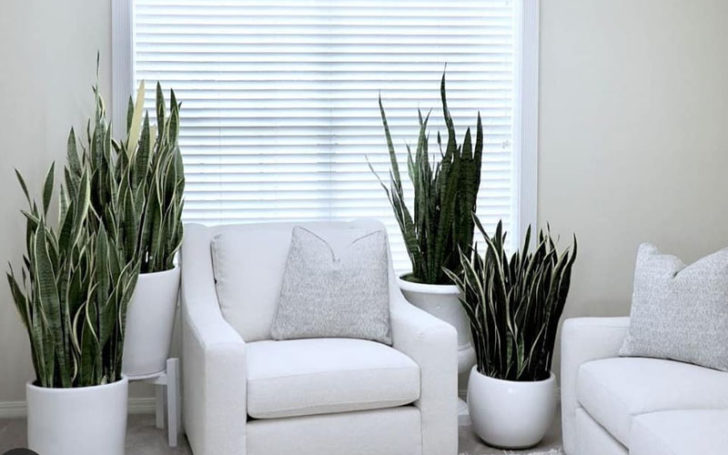
Sansevieria is a species of standing snake, whale fin, paddles, sword, nest, etc., belonging to the family Asparaceae, with more than 70 species. It is a genus of hardiest houseplants with large stiff leaves planted directly from the base.
Other names of Sansevieria are snake plant, snake’s tongue, mother-in-law’s tongue, Viper’s bow hemp, Saint George’s sword, etc. In England it is also called Susie.
Why are the snake plants so popular?
- They are the toughest indoor plants known.
- They can live with less water, less light, ordinary soil and manure.
- It can be easily reproduced by water, soil and division methods.
- They are air purifiers as approved by NASA.
- Less care and maintenance required
- Cheaper to buy, averaging $12 to $35
Taxonomical Hierarchy of Sansevieria
Plantae (Kingdom)
Tracheophyta (Division)
Magnoliopsida (Class)
Asparagales (Order)
Asparagaceae (Family)
Sansevieria (Genus)
70+ (species)
Quick Guide
| Scientific Name | Sansevieria (genus) |
| Common Name | Snake plant, snake’s tongue, mother-in-law’s tongue |
| Native to | Tropical West Africa |
| Size | 1-1.5 m |
| Unique Feature | Identified by NASA as air purifiers |
| Light Need | Bright Indirect |
| Soil Type | Well-drained |
| Soil pH | Alkaline, Neutral |
| USDA Zone | 9 to 11 |
| RHS Hardiness Rating | H1B (see all RHS hardiness ratings) |
Types of Sansevieria
There are more than 70 varieties of Sansevieria in existence today. But we will discuss the most common ones that can be easily found in greenhouses and herb shops.
Sansevieria trifasciata or Dracaena trifasciata
Trifasciata means three bundles. Snake plants in this category have straight yellow stripes around their edges. In the center, there are two different shades of horizontal zigzag green lines.
Let’s look at a few of the Sansevieria trifasciata cultivars below.
1. Sansevieria Trifasciata ‘Laurentii’ (Viper’s Bowstring Hemp)
2. Sansevieria Trifasciata ‘Futura Superba’
3. Sansevieria Trifasciata ‘Futura Robusta’
4. Sansevieria trifasciata ‘Moonshine’
5. Sansevieria Trifasciata ‘Twisted Sister’
6. Sansevieria Trifasciata ‘Golden Hahnii’
7. Sansevieria Trifasciata ‘ Silver Hahnii’
8. Sansevieria Trifasciata ‘Cylindrica’
9. Sansevieria trifasciata variegata ‘White Snake’ or Bentel’s Sensation
Sansevieria Ehrenbergii
Snake plants in this category are succulent and have layers of leaves stacked on top of each other. Each leaf extends away from the center, just as petals bloom in flower.
- Sansevieria Ehrenbergii (Blue Sansevieria)
- Sansevieria Ehrenbergii “Banana”
Other Sansevieria
The following are some of the common snake plants found in the United States and United Kingdom.
- Sansevieria ‘Fernwood Punk’
- Sansevieria Zeylanica (Ceylon Bowstring Cannabis)
- Sansevieria Masoniana F. Variegata
- Sansevieria Kirkii (Star Sansevieria)
- Sansevieria Patens
- Sansevieria ‘Cleopatra’
- Sansevieria Parva (Kenyan Hyacinth)
- Sansevieria Ballyi (Dwarf Sansevieria)
- Sansevieria Eilensis
Snake Plant’s Care (How to Grow Sansevieria)
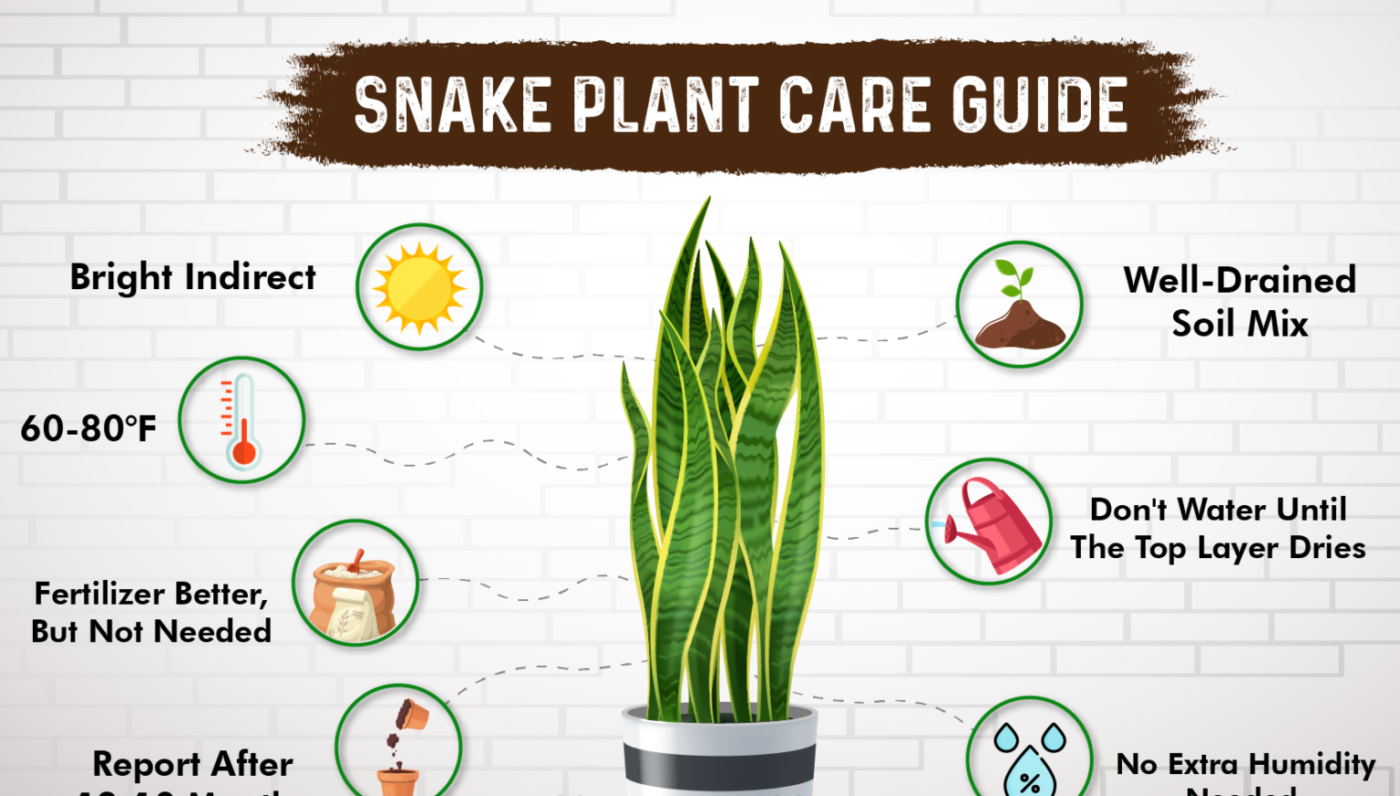
How to care for a snake plant indoors? (Sansevieria care)
Caring for your snake plant is much easier than you think. Water only when the topsoil is dry, ordinary soil mix is fine, fertilize only during the growing season, keep in bright indirect light, and temperature from 55°F to 80°F is fine.
If you are a beginner in gardening, then you need to adopt this plant because it does not require much attention, just like peperomia and Scindapsus pictus plant.
Instead, basic horticultural knowledge can enable you to grow this plant.
The funny thing is, you have to try very hard to kill this plant; otherwise it will survive in harsh conditions.
1. Sansevieria Soil Requirements
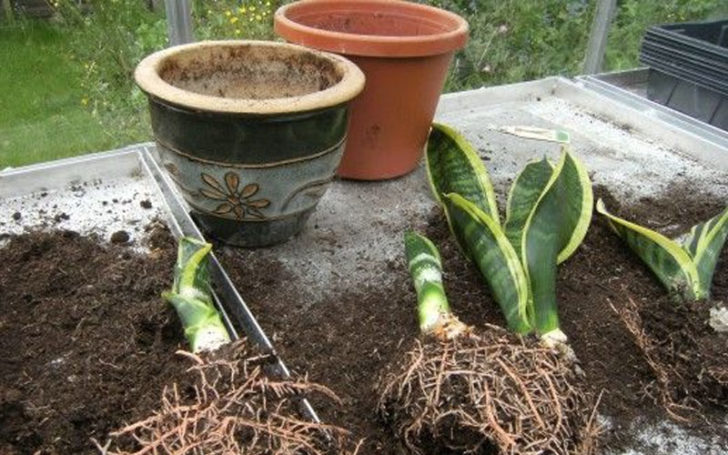
The good thing about snake plants is that they don’t require special soil mix. Instead, it depends on how moist the soil is and how well-drained it is.
Add pumice, perlite, or whatever you usually mix with the soil for more drainage to occur.
But do not add too much to avoid excessive drainage or you can use peat as a water-retaining element with some modifications.
A simple test to check for the right mix is that when you water it it goes down and does not float on the surface of the soil.
How Often Your Snake Pant Needs To Be Repotted?
Almost every plant needs to be repotted after 12-18 months, depending on its growth rate. If it is growing faster, it is necessary to replant it in a slightly larger pot. However, if it is growing more slowly, it is highly recommended to replace the soil with a new one.
2. Snake Plant Watering Guide
How often should you water the snake plant? Sansevieria soil should be completely dry before any re-watering: this is rule number one.
Even if you put it in indirect bright light, you should not water more than once in ten days (tap water is fine). Self-watering controlled baskets can be of great help here.
If the plant is in a terracotta pot, it will dry faster because these clay pots are porous, which tend to absorb water the same way bricks do.
The tip here is if you plan to move your Sansevieria plant sooner, plant it in a light or fully porous pot. Why?
Because, as most people do, if you overwater them, the excess water will be absorbed by the pores of the pot.
Does snake plant pot size matter?

The pot should be neither too big to hold excess water nor too small to inhibit root growth.
Always water the plants with a little shower, not directly with your garden hose, otherwise the strong thick current can damage your plant or drain the soil.
Another obvious factor in irrigation is the exposure of this plant to light. The more light, the faster it dries.
If we summarize the water need, we can say that you should not water the soil without seeing it dry. Otherwise, root rot will occur.
3. Ideal Temperature for Snake Plant
The ideal temperature for a snake plant is between 60-80°F during the day and 55-70F at night.
4. Do Sansevieria plants need extra humidity?
No, it does not need extra moisture. It works almost equally well in the toilet, living room, bedroom in beautiful pots.
5. Light Requirements
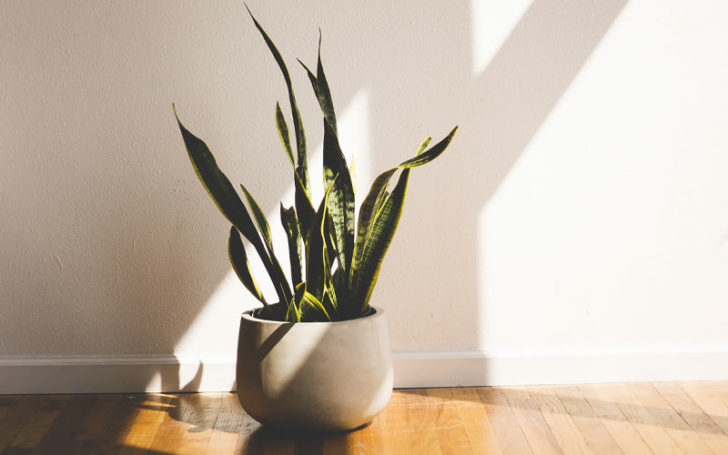
We often label these plants as low light plants as they can survive even in low light.
But that’s not what’s ideal for these plants. Like Alocasia Polly, they grow best in indirect bright sunlight.
In summary, try to place snake plants in an area with medium to bright indirect light.
However, it can survive if there is no good light in your living space.
6. Fertilizer
Snake plants don’t need a lot of fertilizer, but they grow much better if you fertilize 2-3 times during the spring and summer. As a fertilizer, a mixture of fish emulsion and chelated iron is sufficient for Sansevieria.
When you buy a snake plant, you never know how much is left in the nursery.
In other words, the folks at the nursery add a slow-release fertilizer that may have been gone when you bought it.
Therefore, you should fertilize once a month during the growing season. But still, it’s more of an arbitrary question that depends on the actual condition of the plant.
Over-fertilizing, especially when dry, can burn the edges of the leaves as the roots absorb it much faster.
7. USDA Zone
It is in USDA hardiness zone 9 to 11 for snake plant.
8. Pests
Vine lice and mealybugs can sometimes attack snake plants. Vine lice pests are native to Europe but are also common in North America.
These insects can enter the base of the plant when there is too much moisture. A common pesticide can work well against these insects.
9. Diseases
The snake plant is prone to fungal diseases, mostly caused by moisture in the leaves. Let’s look at a few diseases that plague snake plants quite often.
1. Brown Spots
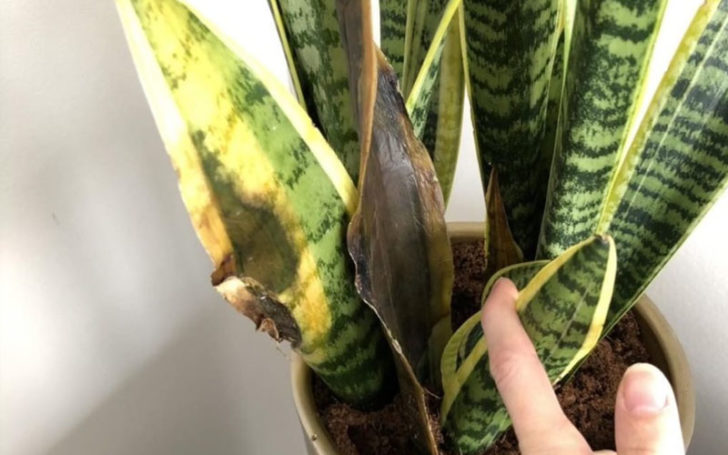
If you see oozing sores on your Sansevieria’s leaves, such as brown spots that spread enough to eat away at the leaf, it’s a sign that you’re overwatering it or that the soil drainage is too bad.
The solution is to undercut the leaf because you can’t do anything to stop it.
2. Red Leaf Spot
Red leaf spot usually appears in the spring and summer when airborne fungal spores find a moist leaf surface to cling to.
The markings include small reddish-brown spots on the leaves with a tan in the middle.
The usual treatment is to remove the affected leaves to prevent further spread.
Watch the video below to find out if your snake plant is dying and how to save it.
10. Pruning
Pruning is more suitable for plants with multiple stems that grow with many leaves, such as myrtle.
This plant needs less pruning. Because you can see that this is a collection of large vertical leaves and nothing more.
Therefore, the only time you should prune this plant is when you see a leaf drooping or affected by any disease such as a bacterial spot on it.
If you like watching content more than reading, the video below can help you with what has been said in the lines above.
Sansevieria is an Air Purifier Plant: Fact or Fiction
Snake plants are some of the plants that release oxygen at night.
It was specifically stated in the journal published by NASA that the mother-in-law’s tongue was an air purifier.
This is the reason why it is even placed in bedrooms as it releases oxygen by absorbing toxins such as formaldehyde, xylene, toluene and nitrogen oxides through its leaves.
But wait,
Some biologists disagree with this myth. According to them, oxygen production by plants can only occur when there is light.
In other words, without light, without photosynthesis and without oxygen.
However, the first school of thought believes that it is not photosynthesis alone that is responsible for oxygen production. Instead, a process called Crassulacean Acid Metabolism (CAM) can also produce oxygen.
But how?
Such plants open their stomata (small pores in the leaves) at night and absorb CO2 even in the presence of room light.
Therefore, we can say that both theories are not wrong. If there is light in the room, it will produce oxygen.
Sansevieria Propagation (How to propagate sansevieria)
There are three ways a snake plant reproduces: water, soil, and division. So, let’s learn about each of them.
1. Propagation by Soil
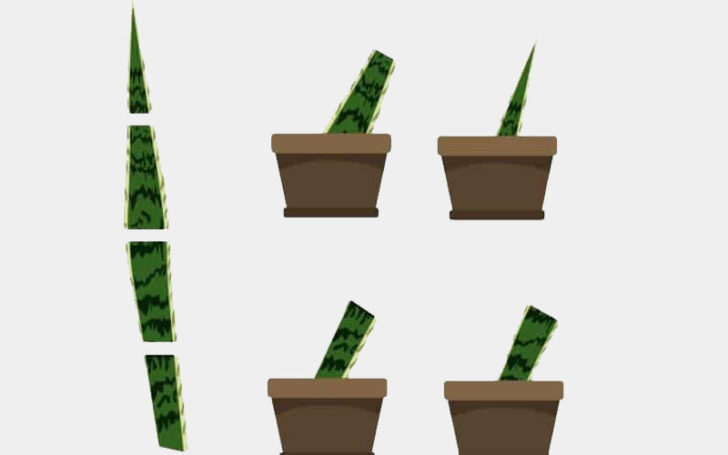
Step 1
As a first step, cut the fully grown leaves from the base. Now, cut this leaf into small cuttings 2-3 inches apart.
When planting these cuttings, be careful to keep the bottom in the ground and the top in the top. Otherwise it will not grow.
Step 2
Either keep the cuttings outside and let them dry for 2-3 days, or water them first into dry soil and then a few days later. This dry soil should be a mix of pot and cactus soil types.
It is always recommended to plant multiple cuttings to increase the chances of successful propagation.
If you are planting cuttings in your garden, a spiral drill planter can be of great help.
Mother-in-law’s tongue is very slow in growth. For example, Sansevieria cylindrical can take up to 3 months even to force new growth.
2. Propagation by Water
Water is easier to propagate because we are used to propagating vine plants like money plant for a long time. Also, being able to see the roots growing makes you prefer this method (picture below).
For snake plants, watering may not be the most effective method.
Why?
Because snake plants are a bit difficult to grow when they are later moved from water to soil.
And you have to be a little careful as it dries quickly.
So, let’s move on to the actual process.
Step 1
It involves the same first step of making cuttings from a leaf as outlined in the Soil Propagation above.
Step 2
There are actually two methods of propagating a snake plant with water. First, dip the underside of the entire leaf, the second is to make cuttings and then dip. Both work fine.
While keeping the direction of the cuttings the same, submerge halfway through the water with the bottom side down and the top side up.
To keep them in the water, you use string, twine, small sticks, or anything else that can make them stand upright, as shown below.
As shown below, either dip them in a large container spaced apart, or submerge 2-3 together in small jars.
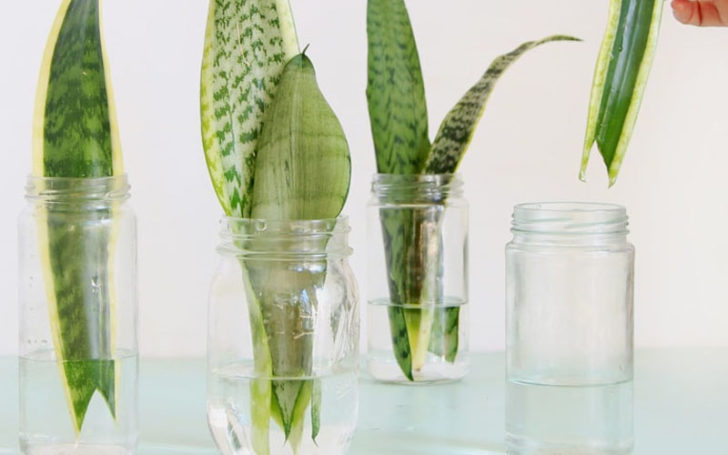
Change the water once or twice a week and be patient as it can take months to root.
Also, not all cuttings form roots. Some may also develop root rot, in which case cut the base to 1-2 inches and re-water.
Now you might ask when is the right time to move cuttings from water to soil.
As a rule of thumb, once the roots have reached 2 inches long, you can transplant them into the soil.
3. Propagation from Division
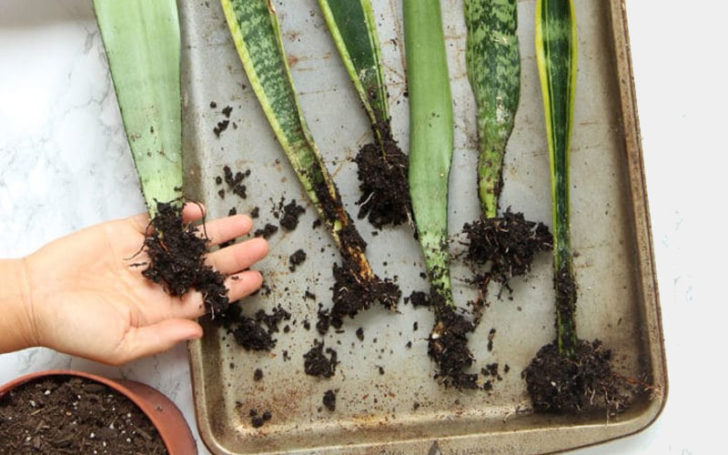
This method is suitable when your pots are clogged with leaves. Therefore, it is better to separate the leaves and make more plants from one.
Alternatively, you can separate new shoots instead of dealing with the whole plant. But either way you need to get the plant out of the pot, that’s for sure.
Step 1
The first thing is to get everything out of the pot. Brush the soil thoroughly until you can see the root structure. If you need to cut off any part of the rhizomes, just do it.
step 2
Now separate each leaf from the others and plant in smaller pots with a maximum of 1-3 leaves per pot.
Take extra care when separating them to avoid damaging their roots.
For a better understanding of the propagation methods described above, see the video below.
Do snake plants produce flowers?
Yes they do.
But if you keep them inside, they won’t. They only get direct or indirect sunlight outside.
Its flowers are different because they are not like ordinary flowers that bloom and have large petals.
Check out a few pictures that show the flowers of different snake plants.
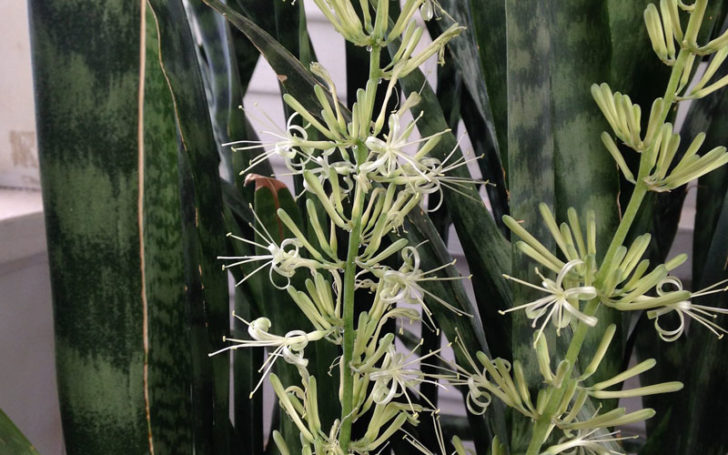
Is Sansevieria Toxic to Cats and Dogs?
According to the American Society for the Prevention of Cruelty to Animals (ASPCA), snake plants are toxic to cats and dogs.
Clinical signs of poison are nausea, vomiting, diarrhea, etc.
Tips to Buy Snake Plants
When purchasing snake plants, prefer green leaves, not light yellow ones. Also, immediately check with the seller if the pot needs to be replaced, in which case buy a terracotta pot with the plant.
Conclusion
Snake plants are, without a doubt, extremely easy to plant. Their unique foliation has made them an integral part of interior design.
That’s why there are many depictions of snake plants in works of art. Some breed it purely for its air-purifying nature, others for its whimsical looks.
If you are a plant lover or looking for a plant for your office or home, this is something you should try. Will you be growing it in your backyard or in your bedroom? Let us know in the comments section.
Also, don’t forget to pin/bookmark and visit our blog for more interesting but original information. (Vodka And Grape Juice)

